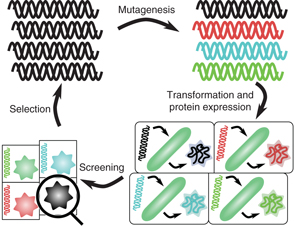Crossref Citations
This article has been cited by the following publications. This list is generated based on data provided by
Crossref.
Roberts, A.D.
Finnigan, W.
Kelly, P.P.
Faulkner, M.
Breitling, R.
Takano, E.
Scrutton, N.S.
Blaker, J.J.
and
Hay, S.
2020.
Non-covalent protein-based adhesives for transparent substrates—bovine serum albumin vs. recombinant spider silk.
Materials Today Bio,
Vol. 7,
Issue. ,
p.
100068.
Gupta, Maneesh K.
Wagner, Drew T.
and
Jewett, Michael C.
2020.
Engineered proteins as multifunctional materials.
MRS Bulletin,
Vol. 45,
Issue. 12,
p.
999.
Yang, Zhongguang
Yang, Yang
Wang, Mo
Wang, Tingting
Fok, Hong Kiu Francis
Jiang, Bojing
Xiao, Wendi
Kou, Songzi
Guo, Yusong
Yan, Yan
Deng, Xin
Zhang, Wen-Bin
and
Sun, Fei
2020.
Dynamically Tunable, Macroscopic Molecular Networks Enabled by Cellular Synthesis of 4-Arm Star-like Proteins.
Matter,
Vol. 2,
Issue. 1,
p.
233.
Poddar, Hashwardhan
Breitling, Rainer
and
Takano, Eriko
2020.
Towards engineering and production of artificial spider silk using tools of synthetic biology.
Engineering Biology,
Vol. 4,
Issue. 1,
p.
1.
Ghaly, Timothy M.
Geoghegan, Jemma L.
Tetu, Sasha G.
and
Gillings, Michael R.
2020.
The Peril and Promise of Integrons: Beyond Antibiotic Resistance.
Trends in Microbiology,
Vol. 28,
Issue. 6,
p.
455.
Burgos-Morales, O.
Gueye, M.
Lacombe, L.
Nowak, C.
Schmachtenberg, R.
Hörner, M.
Jerez-Longres, C.
Mohsenin, H.
Wagner, H.J.
and
Weber, W.
2021.
Synthetic biology as driver for the biologization of materials sciences.
Materials Today Bio,
Vol. 11,
Issue. ,
p.
100115.
Xu, Lianjie
Wang, Xinyu
Sun, Fei
Cao, Yi
Zhong, Chao
and
Zhang, Wen-Bin
2021.
Harnessing proteins for engineered living materials.
Current Opinion in Solid State and Materials Science,
Vol. 25,
Issue. 1,
p.
100896.
Ghaly, Timothy M.
Gillings, Michael R.
Penesyan, Anahit
Qi, Qin
Rajabal, Vaheesan
and
Tetu, Sasha G.
2021.
The Natural History of Integrons.
Microorganisms,
Vol. 9,
Issue. 11,
p.
2212.
Molinari, Sara
Tesoriero, Robert F.
and
Ajo-Franklin, Caroline M.
2021.
Bottom-up approaches to engineered living materials: Challenges and future directions.
Matter,
Vol. 4,
Issue. 10,
p.
3095.
Mukherjee, Manisha
and
Cao, Bin
2021.
Engineering controllable biofilms for biotechnological applications.
Microbial Biotechnology,
Vol. 14,
Issue. 1,
p.
74.
Munro, Lachlan J.
and
Kell, Douglas B.
2021.
Intelligent host engineering for metabolic flux optimisation in biotechnology.
Biochemical Journal,
Vol. 478,
Issue. 20,
p.
3685.
Chang, Marina P.
Huang, Winnie
and
Mai, Danielle J.
2021.
Monomer‐scale design of functional protein polymers using consensus repeat sequences.
Journal of Polymer Science,
Vol. 59,
Issue. 22,
p.
2644.
Fok, Hong Kiu Francis
Yang, Zhongguang
Jiang, Bojing
and
Sun, Fei
2022.
From 4-arm star proteins to diverse stimuli-responsive molecular networks enabled by orthogonal genetically encoded click chemistries.
Polymer Chemistry,
Vol. 13,
Issue. 16,
p.
2331.
Tyrikos-Ergas, Theodore
Gim, Soeun
Huang, Jhih-Yi
Pinzón Martín, Sandra
Varón Silva, Daniel
Seeberger, Peter H.
and
Delbianco, Martina
2022.
Synthetic phosphoethanolamine-modified oligosaccharides reveal the importance of glycan length and substitution in biofilm-inspired assemblies.
Nature Communications,
Vol. 13,
Issue. 1,
Liu, Allen P.
Appel, Eric A.
Ashby, Paul D.
Baker, Brendon M.
Franco, Elisa
Gu, Luo
Haynes, Karmella
Joshi, Neel S.
Kloxin, April M.
Kouwer, Paul H. J.
Mittal, Jeetain
Morsut, Leonardo
Noireaux, Vincent
Parekh, Sapun
Schulman, Rebecca
Tang, Sindy K. Y.
Valentine, Megan T.
Vega, Sebastián L.
Weber, Wilfried
Stephanopoulos, Nicholas
and
Chaudhuri, Ovijit
2022.
The living interface between synthetic biology and biomaterial design.
Nature Materials,
Vol. 21,
Issue. 4,
p.
390.
Sonawane, Jayesh M.
Rai, Ashutosh Kumar
Sharma, Minaxi
Tripathi, Manikant
and
Prasad, Ram
2022.
Microbial biofilms: Recent advances and progress in environmental bioremediation.
Science of The Total Environment,
Vol. 824,
Issue. ,
p.
153843.
Morris, Melody A.
Mills, Carolyn E.
Paloni, Justin M.
Miller, Eric A.
Sikes, Hadley D.
and
Olsen, Bradley D.
2023.
High-Throughput Screening of Streptavidin-Binding Proteins in Self-Assembled Solid Films for Directed Evolution of Materials.
Nano Letters,
Vol. 23,
Issue. 16,
p.
7303.
An, Bolin
Wang, Yanyi
Huang, Yuanyuan
Wang, Xinyu
Liu, Yuzhu
Xun, Dongmin
Church, George M.
Dai, Zhuojun
Yi, Xiao
Tang, Tzu-Chieh
and
Zhong, Chao
2023.
Engineered Living Materials For Sustainability.
Chemical Reviews,
Vol. 123,
Issue. 5,
p.
2349.
Doolan, Jack A.
Alesbrook, Luke S.
Baker, Karen
Brown, Ian R.
Williams, George T.
Hilton, Kira L. F.
Tabata, Makoto
Wozniakiewicz, Penelope J.
Hiscock, Jennifer R.
and
Goult, Benjamin T.
2023.
Next-generation protein-based materials capture and preserve projectiles from supersonic impacts.
Nature Nanotechnology,
Vol. 18,
Issue. 9,
p.
1060.
Montz, Brian J.
and
Emrick, Todd
2024.
Building structured, functional materials inspired by nature: Using peptides, peptoids, and polymerizations.
Journal of Polymer Science,
Vol. 62,
Issue. 16,
p.
3597.


